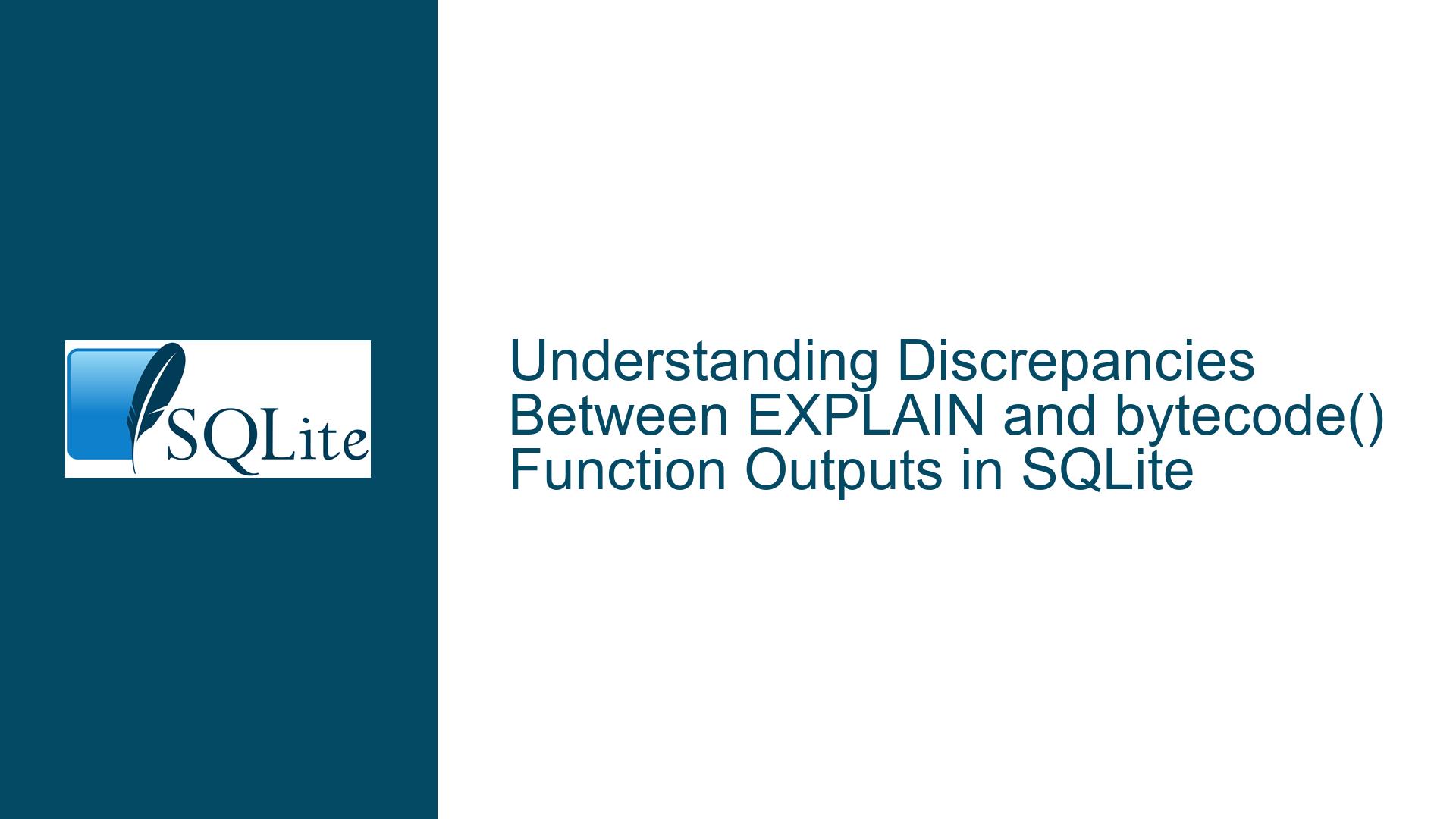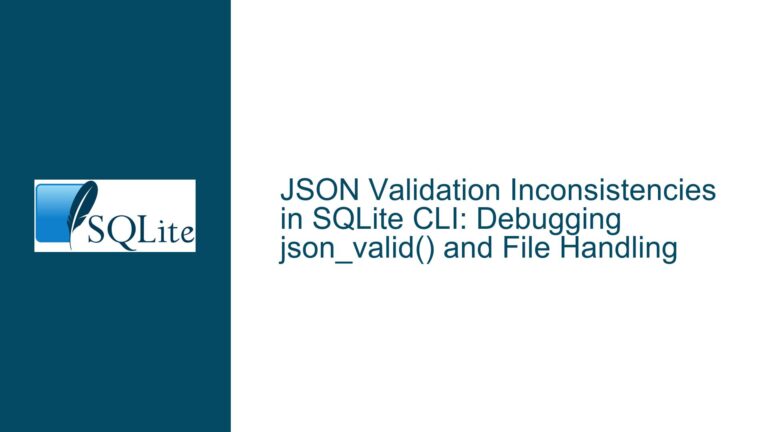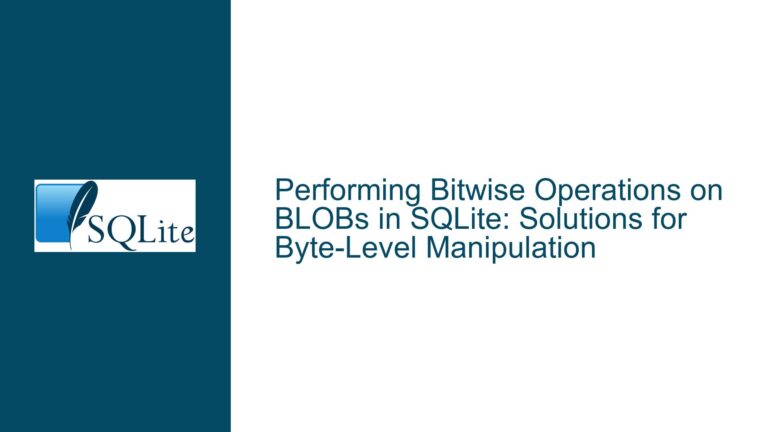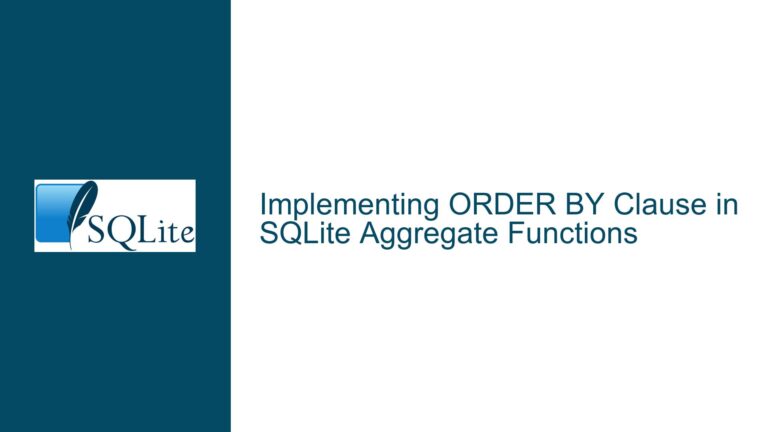Discrepancies Between EXPLAIN and bytecode() Function Outputs in SQLite
Issue Overview: Mismatched Bytecode Outputs Between EXPLAIN and Nested bytecode() Queries
The core issue revolves around unexpected differences in Virtual Database Engine (VDBE) bytecode outputs when comparing the results of SQLite’s EXPLAIN command with queries using the bytecode() table-valued function. Specifically, users observe inconsistencies when attempting to retrieve bytecode for nested queries involving the bytecode() function itself.
Key Observations
Example Experiment:
- A user creates a table
x(y)and executesEXPLAIN SELECT * FROM x;, which returns a specific sequence of VDBE opcodes (e.g.,Init,OpenRead,Rewind). - When running
SELECT * FROM bytecode('SELECT * FROM bytecode("SELECT * FROM x")');, the output differs significantly from theEXPLAINresult. The returned opcodes include additional steps likeTransactionandGoto, which are absent in theEXPLAINoutput.
- A user creates a table
Documentation Example Ambiguity:
- The SQLite documentation provides an example:
SELECT * FROM bytecode('SELECT * FROM bytecode(?1)');. This nested structure raises questions about whether the outerbytecode()call is necessary or if it introduces unintended behavior.
- The SQLite documentation provides an example:
Community Confirmation:
- Contributors in the discussion confirm that the example is overly complex and potentially misleading. The nested use of
bytecode()complicates interpretation, leading to confusion about how the function processes input statements.
- Contributors in the discussion confirm that the example is overly complex and potentially misleading. The nested use of
Technical Context
bytecode()Table-Valued Function:
This function compiles the SQL statement provided in its_stmt_parameter and returns the corresponding VDBE program. It is functionally similar to prependingEXPLAINto a query but abstracts the string manipulation required to generate the bytecode.VDBE Opcodes:
SQLite compiles SQL statements into a sequence of low-level operations executed by the VDBE. These opcodes handle tasks like opening tables (OpenRead), iterating rows (Rewind,Next), and returning results (ResultRow).Nested Queries and Compilation Phases:
Whenbytecode()is nested, the outer query’s compilation process interacts with the inner query’s bytecode generation. This interaction can produce opcodes unrelated to the original statement under investigation (e.g., transaction management opcodes likeTransaction).
Possible Causes: Why Nested bytecode() Queries Produce Unexpected Outputs
1. Compilation Scope Misalignment
The bytecode() function compiles the SQL statement passed to it as part of the outer query’s execution. When nested, the inner bytecode() call is treated as a subquery, leading to two distinct compilation phases:
Outer Query Compilation:
The outerbytecode()function call compiles its input (the innerbytecode()query) into a VDBE program. This includes opcodes for setting up the virtual table scan (OpenReadonbytecode), parameter binding, and result iteration.Inner Query Compilation:
The innerbytecode("SELECT * FROM x")is compiled as a string literal. The outerbytecode()function processes this literal as a standalone statement, generating opcodes for the inner query’s preparation and execution.
This dual compilation introduces opcodes related to the outer query’s execution environment (e.g., Transaction, Goto) that are absent in a simple EXPLAIN output.
2. Hidden Parameters and Side Effects
Implicit Transaction Management:
Thebytecode()function’s execution may implicitly start a transaction to ensure read consistency. TheTransactionopcode observed in the nested query’s output reflects this behavior, which is not present inEXPLAINsinceEXPLAINdoes not execute the query.Virtual Table Overhead:
Thebytecodevirtual table itself requires initialization steps (e.g., opening the virtual table cursor, parameter binding). These steps inject additional opcodes into the output, skewing comparisons withEXPLAIN.
3. Documentation Example Complexity
The example SELECT * FROM bytecode('SELECT * FROM bytecode(?1)'); is designed to demonstrate recursive bytecode inspection. However, this creates a "chicken-and-egg" scenario where the outer bytecode() call’s opcodes overshadow the inner call’s output. Users expecting a direct correspondence between EXPLAIN and bytecode() outputs are misled by the nested structure’s added complexity.
Troubleshooting Steps, Solutions & Fixes: Resolving bytecode() Output Mismatches
Step 1: Simplify the Query
Avoid nesting bytecode() calls when first experimenting with the function. Use a direct statement to isolate the bytecode generation process:
-- Compare with EXPLAIN output
SELECT * FROM bytecode('SELECT * FROM x');
EXPLAIN SELECT * FROM x;
Expected Outcome:
Both queries should produce similar opcodes (Init, OpenRead, Rewind). Minor differences may arise due to virtual table setup in bytecode().
Step 2: Analyze Compilation Phases
Break down nested queries into individual components to identify which opcodes belong to the outer vs. inner compilation:
-- Outer query bytecode (meta-inspection)
SELECT * FROM bytecode('SELECT * FROM bytecode("SELECT * FROM x")');
-- Inner query bytecode (target statement)
SELECT * FROM bytecode('SELECT * FROM x');
Analysis:
- The outer query’s output includes opcodes for scanning the
bytecodevirtual table (OpenRead,Rewind). - The inner query’s output matches the
EXPLAINoutput forSELECT * FROM x.
Step 3: Use EXPLAIN on the bytecode() Query
To debug unexpected opcodes, apply EXPLAIN to the bytecode() query itself:
EXPLAIN SELECT * FROM bytecode('SELECT * FROM x');
Interpretation:
This reveals opcodes for initializing the virtual table scan, which are absent in the bytecode() output. It confirms that bytecode() hides the virtual table’s own execution details.
Step 4: Avoid Nested bytecode() Calls
Replace self-referential examples with simpler statements:
-- Documented example (problematic)
SELECT * FROM bytecode('SELECT * FROM bytecode(?1)');
-- Simplified alternative
SELECT * FROM bytecode('SELECT 1');
Rationale:
The simplified query eliminates nested compilation, making it easier to correlate the input statement with its bytecode.
Step 5: Cross-Validate with tables_used()
Use the tables_used() function to identify dependencies in complex queries:
-- Check tables accessed by the nested query
SELECT * FROM tables_used('SELECT * FROM bytecode("SELECT * FROM x")');
Outcome:
This reveals that the inner query depends on table x, while the outer query depends on the bytecode virtual table. Disambiguating these dependencies clarifies why additional opcodes appear.
Step 6: Review Virtual Table Internals
Understand the implementation of the bytecode virtual table:
- Hidden Parameters: The
_stmt_parameter specifies the SQL statement to compile. - Execution Flow:
The virtual table executesEXPLAIN _stmt_internally, but wraps it in a subquery to avoid altering the database state.
Implication:
The bytecode() function is not a direct passthrough to EXPLAIN; it encapsulates the explained statement within a read-only virtual table scan.
Step 7: Consult Alternative Resources
Refer to SQLite’s explain virtual table, which predates bytecode() and behaves similarly:
-- Compare with bytecode()
SELECT * FROM explain('SELECT * FROM x');
Observation:
The explain virtual table lacks the subprog column but otherwise produces identical opcodes to bytecode().
Step 8: File Documentation Feedback
If the example remains unclear, propose documentation improvements to the SQLite team:
- Highlight the confusion caused by nested
bytecode()calls. - Suggest adding a note clarifying the function’s interaction with compilation phases.
Final Recommendations
Use
bytecode()for Single Statements:
Limit its use to non-nested queries until you’re familiar with its interaction with the VDBE.Prefer
EXPLAINfor Transparency:
When debugging,EXPLAINprovides a more straightforward correspondence between SQL and bytecode.Leverage tables_used() for Dependency Analysis:
This complementsbytecode()by revealing schema objects accessed by a query.
By methodically isolating compilation phases and validating outputs against simpler cases, users can demystify discrepancies between EXPLAIN and bytecode() and leverage both tools effectively.






